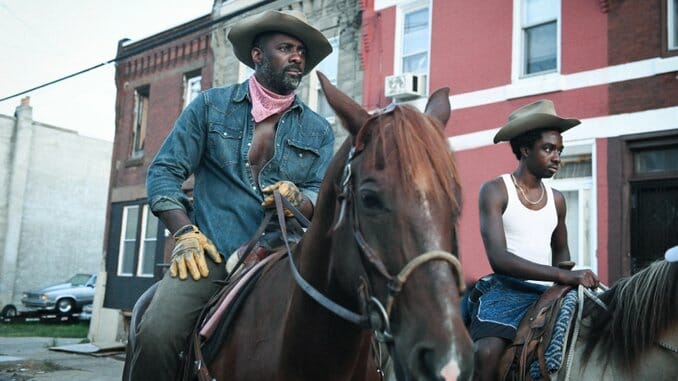Concrete Cowboy‘s Coming-of-Age Tale Trots a Well-Worn Trail

Adam Hollingsworth, AKA Chicago’s Dreadhead Cowboy, went viral last year as he used his horsemanship to help protest social issues ranging from racist police forces to gun violence against children. Some of that viral attention was spurred by racist viewers assuming (and commenting, sharing and spreading rumors) that Hollingsworth had stolen a police horse. Black horse riders are rarely visible, leaving a nice empty vacuum for a country’s prejudices to fill. Hollingsworth might be Chicago’s most visible Black cowboy, but the subculture is represented from coast to coast. Concrete Cowboy takes us through one such community on a lazy pony ride, never wavering from its well-worn coming-of-age trail.
The North Philly denim drama is director Ricky Staub’s feature debut—which he co-adapted from G. Neri’s middle grade novel Ghetto Cowboy with Dan Walser—and sees a Detroit kid who’s gotten into one too many fights on his last chance. Cole (Caleb McLaughlin) gets unceremoniously dropped off to live with his absent father, Harp (Idris Elba), in Philadelphia—and gets stuck choosing between life with his dealing cousin Smush (Jharrel Jerome) and Harp’s group of modern cowpokes at the Fletcher Street Stables.
The path is clear as day ahead: The allure of the cool kids and easy money; the off-putting corniness of and resentment towards the strong/silent dad. I mean, it’s understandable. Harp keeps a horse in his apartment and always wears a Stetson. But then (of course) comes the reversal to teach Cole a lesson about growing up and sticking to the right path, once and for all. And hey, maybe those horses are pretty cool after all. It’s a simple enough plot, and plot is pretty much all Concrete Cowboy cares about. Establishing the community and moving its star from points A to B is done dispassionately and without much in the way of characterization—always a danger when adapting a book whose first-person narrator suddenly loses out on all that interiority. Nothing is asked of McLaughlin and McLaughlin delivers in turn, giving moody stares and typical teen angst. Other chances at emotion are botched by Staub’s shot choices. What’s less predictable is just how little the film gives its actual Black riders to do.
Similarly to Nomadland, Concrete Cowboy has its career actors share scenes with those actually living in the subculture it explores. One, Jamil Prattis (an actual Fletcher Street rider), wisely wields his equestrian expertise to steal scenes, but also has a charismatic enough screen presence that he easily outshines both McLaughlin and Elba. Overcoming Idris Elba in a cowboy hat in any way is a pretty damn impressive feat. However, the rest of the riders barely register. Ivannah Mercedes, the other real-life rider with the most screen time, plays a girl Cole’s got a bit of a crush on and she barely gets a name, let alone any traits. At least Elba’s couple dense speeches explain his entire backstory—otherwise, he’d be just as badly off as McLaughlin, who never shows a hint of personality nor a flash of the kid supposedly so hot-headed that his mother had to drive him across the country.
Since we don’t really have characters and we pretty much know how this story is going to go, all we’re left with is images—and Staub proves himself a greenhorn every step of the way. The script, for all its by-the-numbers structure, still has plenty of potential for some engaging and unique moments. People don’t know about modern, Black, urban cowboys. And with Elba’s gravitas, even the most telegraphed father-son moment should draw forth a manly tear or two. But just as the film dodges characterization, settling on a broad overview of a community through stock archetypes sitting around in exposition circles doling out history lessons like a bunch of Wikipedia pages shooting the shit, Staub’s camera dodges meaningful compositions.
For example, a scene about intimacy and closeness—where Cole and Harp have it out in the latter’s cramped and crappy apartment—has no sense of space. Shot in a location that’s confines should always weigh heavy on its content, the back-and-forth speeches (Cole wondering why his estranged father seems to have more affinity for the riding community than for him; Harp explaining his troubled past) exist in isolation. Hung up in wavering handheld close-ups that mask any of the actors’ movements or growing connection between the two characters, the pair barely seem to exist on the same plane until the scene ends. That could be a tactic, done well, where intentional separation underlines their emotional distance. Here, it’s a sloppy mistake.
-

-

-

-

-

-

-

-

-

-

-

-

-

-

-

-

-

-

-

-

-

-

-

-

-

-

-

-

-

-

-

-

-

-

-

-

-

-

-

-








































